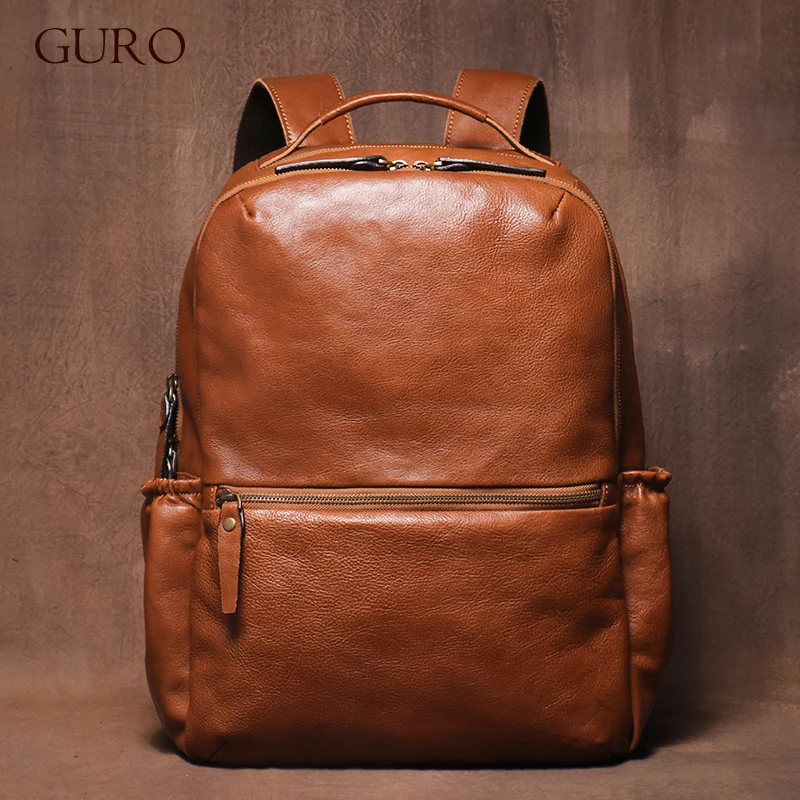Introduction: The Timeless Appeal of Leather Rucksacks
Few accessories combine practicality and style like a well-crafted leather rucksack. These timeless bags have remained popular for generations, and for good reason. A quality leather rucksack offers exceptional durability, a distinctive aesthetic appeal that stands apart from synthetic alternatives, and functionality that adapts to modern needs while maintaining classic charm.
What makes leather rucksacks truly special is how they develop character over time. Unlike mass-produced synthetic bags that degrade and look worn out, premium leather develops a rich patina with use. Each scratch, mark, and subtle color change tells a story, making your rucksack uniquely yours as it ages.
Investing in a leather rucksack is a decision that deserves careful consideration. The right choice can provide decades of reliable service, while a poor selection might leave you disappointed within months. This guide to buying a leather rucksack aims to equip you with the knowledge needed to make an informed decision that matches your needs, style preferences, and budget.
Before spending your hard-earned money, it’s essential to understand what separates an exceptional leather rucksack from a mediocre one. We’ll explore everything from leather quality and craftsmanship to practical considerations like size, comfort, and organization features. Whether you’re seeking a daily companion for work, school, or travel, this comprehensive guide will help you navigate the world of leather rucksacks with confidence.
Understanding Leather Quality: The Foundation of Your Investment
When shopping for a leather rucksack, the most critical factor to consider is the leather quality. This foundation determines everything from how your bag looks and feels to how it will perform and age over the coming years.
Full-Grain Leather: The Gold Standard
Full-grain leather backpacks represent the highest quality available. This premium material comes from the top layer of the hide and includes the entire grain surface with all its natural characteristics:
- Features visible natural markings, pores, and subtle variations that prove authenticity
- Extremely durable due to the dense fiber structure that hasn’t been altered or sanded
- Develops a beautiful patina over time, becoming more attractive with age
- Naturally resistant to moisture and wear
- Typically thicker and more substantial feeling
When examining full-grain leather, look for visible natural texture, slight imperfections that indicate authenticity, and a substantial weight that speaks to its optimal leather thickness.
Top-Grain Leather: The Practical Middle Ground
Top-grain leather is the second-highest quality and offers a good balance of quality and affordability:
- The uppermost layer has been sanded to remove imperfections
- More uniform in appearance than full-grain
- Thinner and more workable, but still quite durable
- Develops some patina, though not as distinctive as full-grain
- Often treated with a finish that improves stain resistance
Understanding the key differences between full-grain and top-grain leather will help you make a more informed choice based on your priorities and budget.
Genuine Leather: A Misleading Term
Despite what the name suggests, “genuine leather” is actually a lower grade:
- Made from the layers remaining after top-grain leather is removed
- Often heavily processed and coated to mimic higher grades
- Less durable and prone to peeling or cracking over time
- Limited breathability and minimal character development
- Significantly shorter lifespan than full or top-grain options
Bonded Leather: Not Recommended for Rucksacks
Bonded leather is essentially the “particle board” of leather products:
- Made from leather scraps and fibers glued together
- Coated with polyurethane and embossed with a leather-like texture
- Prone to peeling, cracking, and rapid deterioration
- Not suitable for items requiring durability like rucksacks
- Often misleadingly marketed as real leather
Specialty Leathers
Some rucksacks feature specialty leathers with unique characteristics:
- Crazy Horse Leather: Oil-treated leather that develops an attractive distressed look with use
- Vegetable-Tanned Leather: Tanned using natural materials instead of chemicals, developing rich patina and aging beautifully
- Pull-Up Leather: Treated with oils and waxes that cause color variation when pulled or bent, creating a vintage effect
When comparing rucksacks, the leather quality directly impacts longevity. Full-grain leather bags can last decades with proper care, while bonded leather might deteriorate within a year or two of regular use. This stark difference in lifespan makes leather quality the most important factor in determining the true value of your investment.
Craftsmanship Details: Evaluating Construction Quality
Even the finest leather can be undermined by poor construction. Quality craftsmanship ensures your rucksack will withstand the test of time and maintain its structural integrity through years of daily use.
Stitching: The Foundation of Durability
The stitching of a leather rucksack tells you much about its overall quality:
- Saddle Stitching: This traditional hand-stitching technique creates the strongest seams. Each stitch is independent, so if one breaks, the entire seam won’t unravel.
- Machine Stitching: Look for tight, even stitching with no loose threads or skipped stitches. Double stitching at stress points indicates attention to durability.
- Thread Quality: Waxed thread or polyester thread offers better resistance to moisture and abrasion than cotton thread.
When inspecting stitching, check that seams are straight, stitches are even in spacing and tension, and there are no loose threads or fraying edges.
Hardware: The Daily Touchpoints
The metal components of your rucksack will be handled daily and should be built to last:
- Zippers: Look for branded, heavy-duty metal zippers (like YKK) that operate smoothly. Plastic zippers are a red flag for quality concerns.
- Buckles and Clasps: Solid brass or stainless steel buckles will outlast plated metals that may chip or corrode.
- Rivets and Studs: These should be properly installed, with no sharp edges, and secured firmly to the leather.
Quality hardware should feel substantial in hand and operate smoothly without catching or requiring excessive force.
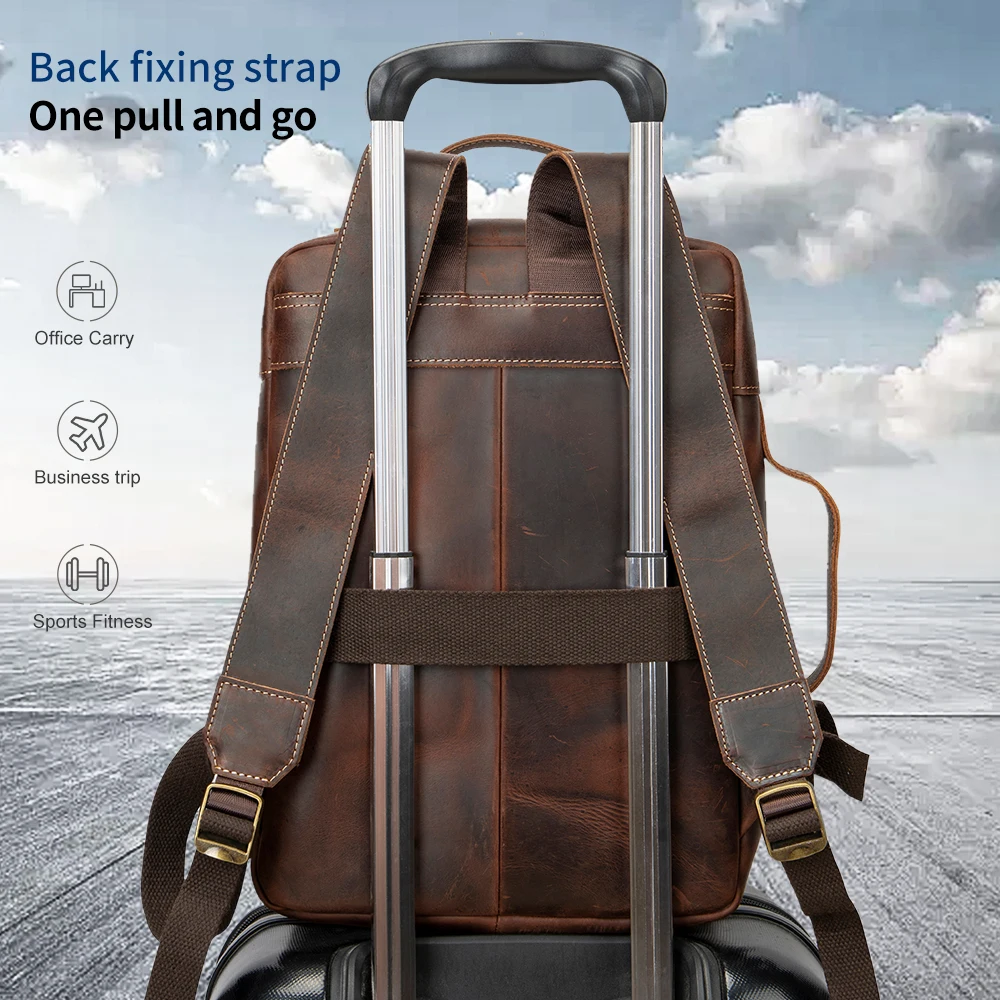
Stress Points: Where Durability Is Tested
Pay special attention to areas that bear the most weight and pressure:
- Reinforced stitching at strap attachments
- Double-layered leather or extra rivets at handle connections
- Reinforced bottom panel that can support weight without sagging
- Robust connection points where the shoulder straps meet the bag body
These reinforcements significantly extend the lifespan of a rucksack and demonstrate the manufacturer’s commitment to durability.
Lining Choices
The interior lining affects both functionality and longevity:
- Canvas or cotton twill linings are durable and easy to clean
- Synthetic linings may be more water-resistant but often less breathable
- Quality linings are securely attached with no loose edges
- Dedicated laptop compartments should feature padded protection
Edge Finishing Techniques
How the edges of leather pieces are finished reveals much about attention to detail:
- Burnished Edges: Edges are polished smooth and sealed, indicating high-quality finishing
- Painted Edges: Paint applied to seal raw edges, acceptable but less premium
- Raw Edges: Unfinished edges that may fray or deteriorate faster, typically a sign of cost-cutting
When looking for quality in a leather rucksack, examine how the craftsperson has addressed these often-overlooked details. The way edges are finished impacts not only the bag’s appearance but also its resistance to wear and moisture penetration.
A well-crafted leather rucksack will feature consistent attention to detail throughout. Even small elements like interior pocket reinforcement, edge coating uniformity, and symmetrical alignment of components speak volumes about the overall quality you can expect.
Determining the Right Size and Capacity for Your Needs
Choosing the perfect size for your leather rucksack is crucial – too small and it won’t accommodate your essentials; too large and it becomes cumbersome or looks disproportionate on your frame. The key is finding the sweet spot that matches your typical carrying needs.
Assessing Your Daily Carry Requirements
Before exploring specific sizes, take inventory of what you regularly carry:
- Electronic devices (laptop, tablet, e-reader)
- Work or school materials (notebooks, folders, books)
- Personal items (wallet, phone, keys, sunglasses)
- Other essentials (water bottle, umbrella, lunch container)
- Occasional items (gym clothes, small shopping purchases)
Having a clear understanding of your typical load helps narrow down appropriate size options.
Standard Rucksack Sizes and Their Practical Applications
Leather rucksacks generally fall into these capacity categories:
Compact (13-18 liters / 800-1100 cubic inches)
Best for minimalists and daily urban use
– Accommodates a tablet, small notebook, wallet, phone, keys
– Perfect for coffee shop visits, short outings, or light errands
– Maintains a sleek profile that works well with formal and casual attire
Medium (18-22 liters / 1100-1350 cubic inches)
Ideal for professional environments and daily commuters
– Fits a standard 13-15” laptop, notebook, charger, water bottle
– Provides space for a light jacket or small accessories
– Balances carrying capacity with a professional appearance
– Most versatile size for everyday use
Large (25-35 liters / 1500-2100 cubic inches)
Suitable for travel, students, or those carrying bulkier items
– Accommodates larger laptops (15-17”), textbooks, lunch containers
– Provides extra space for gym clothes or overnight essentials
– Works well for larger capacity needs without becoming unwieldy
The right backpack size depends not just on what you carry but also your body frame. A rucksack should look proportional to your body—overly large bags can overwhelm smaller frames, while undersized rucksacks may look awkward on larger individuals.
Key Measurements to Consider
When evaluating rucksack dimensions, focus on:
- Height: Determines how much vertical space you have for taller items
- Width: Affects how the bag sits on your back and what fits inside
- Depth: Impacts the bag’s profile when worn and total volume
- Weight: Empty weight before adding your items (heavier isn’t always better)
A well-designed leather rucksack sizing guide can help you visualize these dimensions in relation to everyday items.
Weight Considerations
Remember that leather is naturally heavier than synthetic materials. A full-grain leather rucksack will have substantial weight even when empty. Consider this base weight when determining the appropriate size, as carrying too much in an already heavy bag can lead to discomfort during extended use.
Essential Functionality and Organization Features
The internal and external organization of a leather rucksack significantly impacts its practicality for daily use. A thoughtfully designed bag balances accessible storage with clean aesthetics.
Main Compartment Design and Access
How you access the main compartment affects both security and convenience:
- Top-loading designs provide excellent security but may make retrieving items at the bottom challenging
- Front-panel openings offer easier access to contents but typically rely on zippers which can be a failure point
- Drawstring closures with flap covers balance accessibility with traditional aesthetics
- Roll-top designs provide expandable capacity and excellent weather resistance
Many premium roll-top leather backpacks combine traditional aesthetics with modern functionality, allowing you to adjust capacity based on daily needs.
Internal Organization Systems
The interior arrangement determines how efficiently you can store and retrieve items:
- Laptop sleeve: Look for padded compartments sized appropriately for your device
- Document pockets: Flat pockets keep papers organized and prevent creasing
- Small item storage: Dedicated spaces for pens, cards, and accessories prevent items from becoming lost at the bottom
- Key leash: A tethered key clip saves time searching for keys
Well-designed organized compartments transform a simple bag into a mobile organizational system. Consider how the interior layout matches your specific carrying habits.
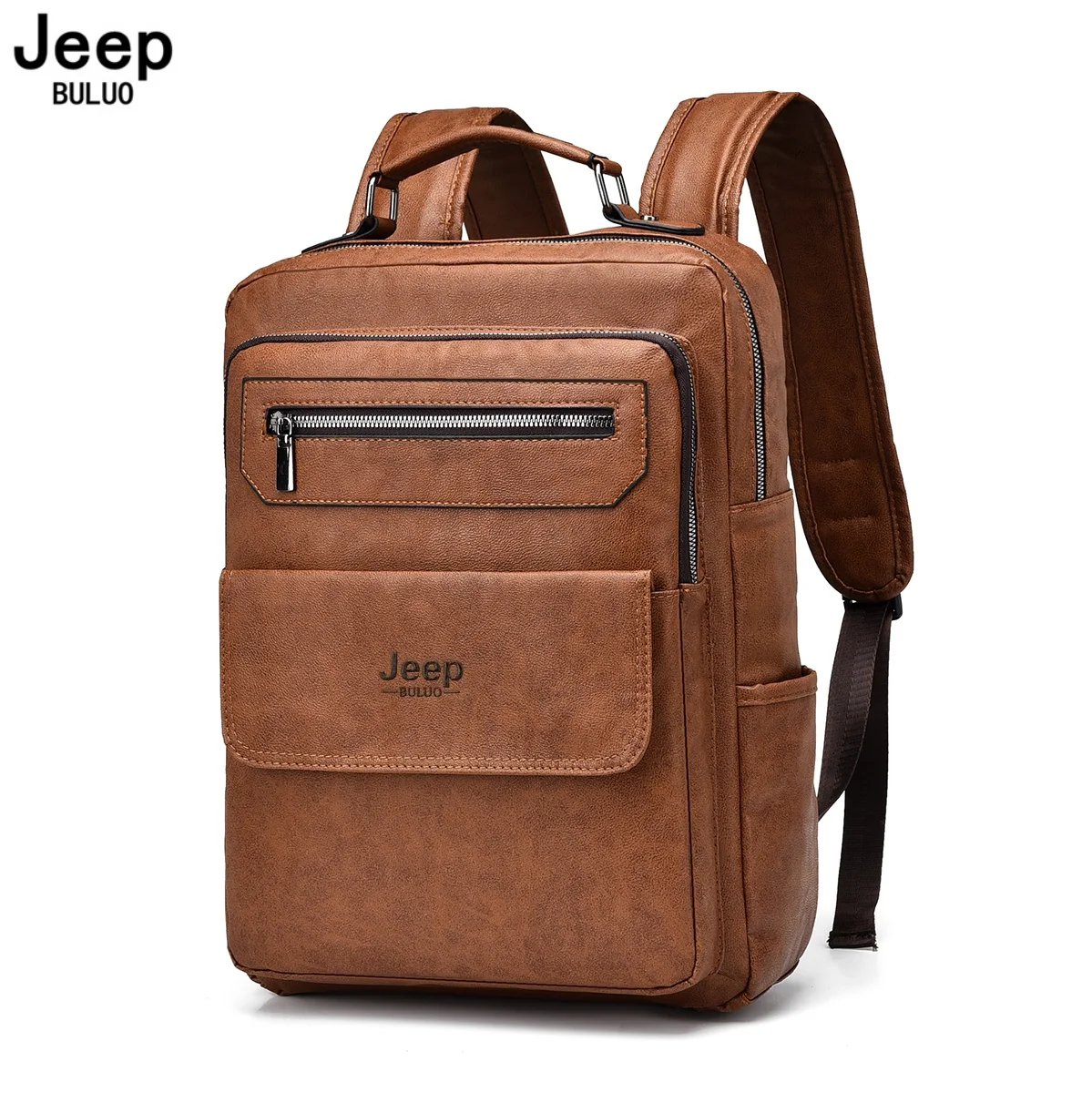
External Pocket Configurations
External pockets provide quick access to frequently used items:
- Front pockets: Ideal for items needing immediate access like transit cards or phones
- Side pockets: Perfect for water bottles or umbrellas
- Hidden back pockets: Secure storage for valuables while traveling
The security and accessibility of these pockets depend largely on their closure mechanisms, each with distinct advantages:
- Magnetic closures: Offer quick, one-handed operation but less security
- Buckles: Provide classic aesthetics and security but take longer to open and close
- Zippers: Balance security and convenience when quality hardware is used
- Snap buttons: Blend traditional appearance with moderate convenience
Security Features
Consider how the rucksack protects valuable contents:
- Anti-theft features like hidden compartments
- RFID-blocking pockets for credit cards and passports
- Secure closures that cannot be easily opened by others
- Locking capabilities for travel scenarios
Matching specific rucksack features to your use case ensures the bag enhances rather than hinders your daily routine. A weekend traveler needs different organization than a daily office commuter or a university student.
Remember that excessive organization can sometimes add unnecessary weight and complexity. The ideal arrangement provides just enough structure to keep your items accessible and protected without overly compartmentalizing the space.
Comfort and Ergonomics: Ensuring Daily Carrying Pleasure
Even the most beautiful leather rucksack will remain unused if it’s uncomfortable to wear. Ergonomic design ensures that your rucksack becomes a pleasant companion rather than a burden.
Shoulder Strap Design
The straps are your primary contact point with the bag and significantly impact comfort:
- Width: Wider straps distribute weight more evenly across your shoulders
- Padding: Look for dense, high-quality padding that won’t flatten over time
- Contoured shape: Straps that curve to follow your shoulder’s natural contour prevent slipping
- Adjustability: Sufficient length adjustment accommodates different heights and layered clothing
- Attachment points: Reinforced connections to the bag body prevent tearing under stress
Quality leather straps often start firm but become remarkably comfortable as they mold to your body shape with use.
Back Panel Construction
The area that rests against your back affects both comfort and breathability:
- Padding design: Should provide support while allowing flexibility
- Ventilation channels: Help reduce heat buildup during extended wear
- Materials: Breathable fabrics or perforated leather minimize sweating
- Structure: Prevents the bag’s contents from creating uncomfortable pressure points
Weight Distribution Principles
How a rucksack distributes weight across your body dramatically affects comfort:
- Load positioning: Weight should rest primarily in the middle and upper portion of your back
- Compression systems: Straps that cinch contents prevent shifting while walking
- Balance point: The bag should hang properly when filled, not pulling backward excessively
Understanding proper backpack weight distribution techniques can significantly improve comfort, especially for heavier loads or longer carrying periods.
Top Handle Design
Often overlooked, the top handle is essential for:
– Briefly carrying the rucksack when removing it
– Hanging the bag on hooks or doorknobs
– Providing an alternative carrying method for short distances
Look for a handle that’s firmly anchored, comfortable to grip, and proportionate to the bag’s size.
Adapting to Different Body Types
A well-designed rucksack accommodates various body shapes and sizes:
- Strap placement: Properly positioned to work for different shoulder widths
- Adjustment range: Sufficient to fit both smaller and larger frames
- Proportional sizing: The bag’s dimensions should complement your body size
When testing a rucksack for comfort, fill it with a typical load weight and wear it for several minutes. Pay attention to pressure points, strap positioning, and how the weight feels distributed across your back. Small discomforts can become significant irritations after hours of wear.
Style and Aesthetics: Choosing a Timeless Design
A leather rucksack is more than a utilitarian item—it’s a style statement that complements your personal aesthetic and can elevate your overall appearance. Selecting a design that balances contemporary functionality with timeless appeal ensures your investment remains stylish for years to come.
Classic vs. Contemporary Designs
Leather rucksacks generally fall into style categories that influence their versatility:
- Heritage/Traditional: Features classic elements like flap-overs, buckle closures, and minimal external hardware. These designs have remained essentially unchanged for decades and rarely look dated.
- Modern Minimalist: Clean lines, subtle hardware, and simplified silhouettes that pair well with both casual and formal attire.
- Hybrid Styles: Combine traditional leather craftsmanship with modern conveniences like external USB ports or specialized device pockets.
- Vintage-Inspired: Vintage leather backpack designs incorporate distressed finishes and antique hardware for a deliberately aged appearance straight from purchase.
Understanding vintage-inspired leather backpack designs can help you choose a rucksack with enduring appeal rather than following short-lived trends.
Color Selection and Versatility
The color of your leather rucksack affects its versatility and how it ages:
- Dark Brown: The most versatile option, pairing well with nearly any outfit while hiding minor scuffs and developing rich patina.
- Medium Brown: Brown leather backpacks strike an excellent balance between casual and formal, aging beautifully with pronounced character development.
- Black: Projects formality and professional polish, shows scratches more readily but pairs seamlessly with business attire.
- Tan/Natural: Develops the most dramatic patina over time, showcasing the leather’s natural aging process.
- Oxblood/Burgundy: Offers distinctive character while remaining versatile enough for daily use.
Consider how your color choice complements your typical wardrobe and the environments where you’ll use the rucksack most frequently.
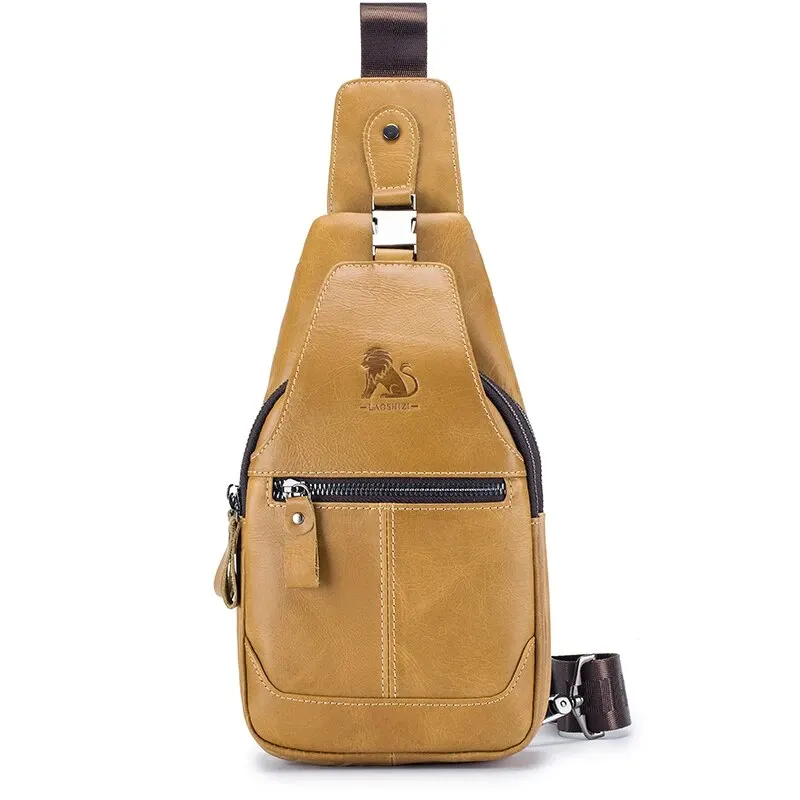
Design Elements That Remain Timeless
Certain features have stood the test of time and continue to look appropriate regardless of changing trends:
- Simple, symmetrical proportions
- Minimal visible branding or logos
- Quality metal hardware in brass, nickel, or antiqued finishes
- Clean stitching that serves functional rather than decorative purposes
- Thoughtful leather edge treatments
These elements form the foundation of leather backpack styles that remain relevant despite fashion’s cyclical nature.
Balancing Personal Style with Functionality
The most successful rucksack choice marries your aesthetic preferences with practical needs:
- Consider how the bag’s appearance complements your most common outfits
- Evaluate whether the style works across multiple settings (office, travel, casual)
- Ensure design elements don’t compromise functionality (decorative straps that impede access, for example)
- Think about the bag’s appropriateness for your professional environment
Remember that a truly well-designed leather rucksack will age gracefully, developing character that enhances rather than diminishes its appearance over time.
Durability and Longevity: Making a Lasting Investment
A quality leather rucksack represents a long-term investment that can provide decades of service when properly selected and maintained. Understanding what contributes to longevity helps you evaluate whether a higher initial cost truly delivers greater value over time.
Material Impact on Lifespan
The leather type forms the foundation of durability:
- Full-grain leather can last 30+ years with proper care
- Top-grain leather typically provides 10-20 years of service
- Genuine leather often shows significant wear after 3-5 years
- Bonded leather may deteriorate within 1-2 years
This stark difference in potential lifespan makes material quality the primary determinant of long-term value. A full-grain leather rucksack might cost twice as much as one made from genuine leather, but could last five times as long.
Critical Construction Elements
Beyond the leather itself, these construction details significantly impact durability:
- Stress point reinforcement: Double-layered leather or rivets at connection points
- Edge treatment: Properly finished and sealed edges resist moisture and fraying
- Stitching quality: Dense, even stitching with strong thread prevents seam failure
- Hardware attachment method: How buckles and D-rings are secured affects long-term durability
When comparing leather rucksack designs, examine these structural elements rather than focusing solely on aesthetic differences.
Understanding Warranties and Guarantees
A manufacturer’s warranty often reflects their confidence in their product:
- Lifetime warranties against defects suggest exceptional durability expectations
- Limited warranties that exclude “normal wear and tear” require careful reading
- The reputation of the company for honoring warranties matters as much as the terms
A comprehensive warranty from a reputable manufacturer provides assurance that your investment is protected.
Signs of a Rucksack Built to Last
Beyond marketing claims, these tangible indicators suggest superior longevity:
- Heavy-duty hardware with solid (not hollow) construction
- Reinforced stress points where straps connect to the body
- Minimal stretching when the bag is lifted while fully loaded
- Clean, even stitching with no loose threads
- Sufficient leather thickness appropriate for structural components
The Cost-Per-Use Calculation
Rather than focusing solely on purchase price, consider the total value over the product’s lifetime:
Initial Cost ÷ (Frequency of Use × Years of Service) = Cost Per Use
For example, a $300 rucksack used 200 days per year for 10 years costs just 15 cents per use. By comparison, a $100 bag that lasts only 2 years costs 25 cents per use – making the more expensive bag the better long-term value.
This perspective often justifies investing in higher quality, as the true cost of ownership decreases significantly with extended usable life.
Essential Care and Maintenance for Leather Rucksacks
Proper maintenance dramatically extends your leather rucksack’s lifespan while preserving its appearance. Establishing a regular care routine ensures your investment continues to look and perform its best for years to come.
Basic Cleaning Routine
Regular cleaning prevents dirt buildup that can damage leather over time:
- Empty all contents and shake out interior debris
- Wipe the exterior with a slightly damp, soft cloth
- For soiled areas, use a mild leather cleaner designed for your specific leather type
- Clean along seams and in crevices with a soft brush
- Allow to air dry completely away from direct heat sources
- Clean interior fabric lining with a lightly damp cloth and mild soap if needed
Regular leather backpack care and maintenance prevents the need for more intensive restoration later.
Conditioning: The Key to Leather Health
Conditioning replenishes natural oils that keep leather supple and resistant to cracking:
- Apply a small amount of leather conditioner to a clean, soft cloth
- Test in an inconspicuous area first to check for any color changes
- Work the conditioner into the leather using circular motions
- Pay special attention to flex points and edges where drying occurs first
- Allow the leather to absorb the conditioner (typically 1-2 hours)
- Buff with a clean cloth to remove excess product
Most leather rucksacks benefit from conditioning every 3-6 months, depending on climate and frequency of use. Dry environments require more frequent conditioning.
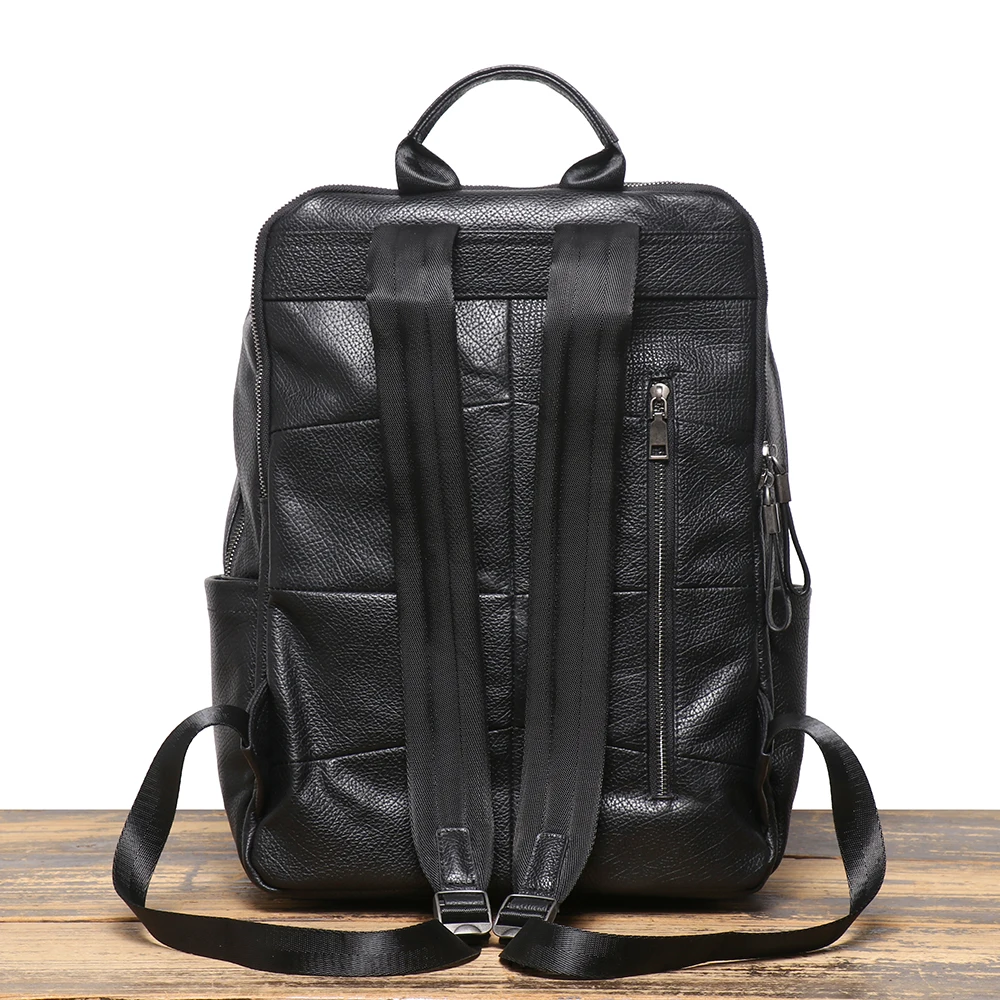
Water and Stain Protection
While most quality leather has natural water resistance, additional protection helps:
- Choose a leather protector appropriate for your specific leather type
- Apply evenly in thin coats rather than one heavy application
- Allow to dry completely between coats
- Reapply protection every few months or after intensive cleaning
Learning proper leather conditioning and waterproofing techniques helps prevent damage from unexpected rain or spills.
Proper Storage When Not in Use
How you store your rucksack when not in use significantly impacts its condition:
- Store in a breathable cotton dust bag, never in plastic
- Stuff with acid-free tissue paper to maintain shape
- Keep in a cool, dry place away from direct sunlight
- Avoid hanging by straps for extended periods to prevent stretching
- Apply conditioner before storing long-term
Hardware Maintenance
Metal components require their own care routine:
- Clean metal hardware with a soft cloth
- Apply a light coating of metal polish to brass or copper fittings if tarnished
- Ensure zippers run smoothly by cleaning tracks with a small brush
- Apply zipper lubricant if zippers begin to stick
Addressing Common Issues
Quick responses to common problems prevent lasting damage:
- Water spots: Allow to dry naturally, then apply conditioner
- Minor scratches: Often removed with conditioning or specialized leather balm
- Stubborn stains: Consult a leather care professional rather than experimenting with harsh cleaners
- Loose stitching: Address immediately before it expands
- Fading: Condition regularly and minimize sun exposure
Remember that quality leather is meant to develop character over time. Small scratches and subtle color variations often enhance rather than detract from the rucksack’s appearance, creating a unique patina that tells the story of your journeys together.
Budget Considerations: Balancing Price and Value
When investing in a leather rucksack, understanding the relationship between price and value helps ensure you make a purchase you’ll be satisfied with for years to come.
Price Range Expectations
Leather rucksacks span a wide price spectrum, generally falling into these categories:
- Entry-level ($100-200): Typically made from genuine leather with basic construction. May use leather primarily on exterior panels with synthetic materials elsewhere.
- Mid-range ($200-350): Usually features top-grain leather with improved craftsmanship, better hardware, and more thoughtful design details.
- Premium ($350-600): Full-grain leather construction with high-quality hardware, superior craftsmanship, and comprehensive warranties.
- Luxury ($600+): Luxury leather backpacks offer exceptional materials, hand-craftsmanship details, and designer aesthetics beyond functional considerations.
Within each range, prices vary based on size, complexity, and brand positioning.
Legitimate Price Factors vs. Marketing Markup
Understanding what genuinely affects production costs helps identify fair pricing:
Legitimate Factors That Increase Cost:
– Higher quality leather (full-grain vs. genuine)
– Leather thickness and quantity used
– Hand-stitching vs. machine construction
– Premium hardware (solid brass vs. plated metal)
– Design complexity and number of components
– Ethical labor practices and production location
– Comprehensive warranty coverage
Less Justified Price Factors:
– Excessive brand premium without corresponding quality
– Trendy design elements without functional benefit
– Celebrity endorsements or marketing campaigns
– Limited edition status without material improvements
– Elaborate packaging that adds no value to the product itself
Value Assessment Beyond Price Tag
True value encompasses more than the initial purchase price:
- Longevity: A bag that lasts three times longer may justify costing twice as much
- Versatility: The ability to use one bag across multiple contexts increases its value
- Timeless Design: Styles that resist looking dated provide better long-term value
- Warranty Coverage: Comprehensive protection against defects reduces lifetime cost
- Repair Potential: Bags designed to be repaired rather than replaced offer superior long-term value
When Higher Prices Are Justified
Premium pricing is often warranted when:
– Materials are genuinely superior (full-grain vs. lower grades)
– Construction techniques enhance durability (saddle stitching vs. machine stitching)
– Design incorporates thoughtful functional elements that improve usability
– The company stands behind their product with excellent warranty service
Brands like Summit Carry justify higher prices through superior materials, craftsmanship focused on longevity, and designs that balance aesthetics with practical functionality.
What to Look for When Shopping: A Practical Checklist
Armed with knowledge about leather quality, craftsmanship, and design, use this practical checklist when evaluating potential rucksacks to ensure you select a bag that meets your needs and quality expectations.
In-Person Shopping Inspection Techniques
When examining a leather rucksack in person:
Leather Assessment
– Feel the texture (full-grain leather has visible natural grain)
– Check thickness and pliability (should be substantial but not rigid)
– Smell the leather (genuine leather has a distinctive natural scent)
– Examine edge finishing (should be smooth and sealed)Construction Evaluation
– Inspect stitching (even spacing, no loose threads)
– Check hardware attachment points (securely riveted or stitched)
– Test zippers and closures (should operate smoothly)
– Examine interior lining (securely attached without wrinkles)Functionality Testing
– Try the empty bag on for comfort and fit
– Adjust all straps to assess range and mechanism
– Open and close all compartments to evaluate access
– Test how the bag stands when set down (stability)
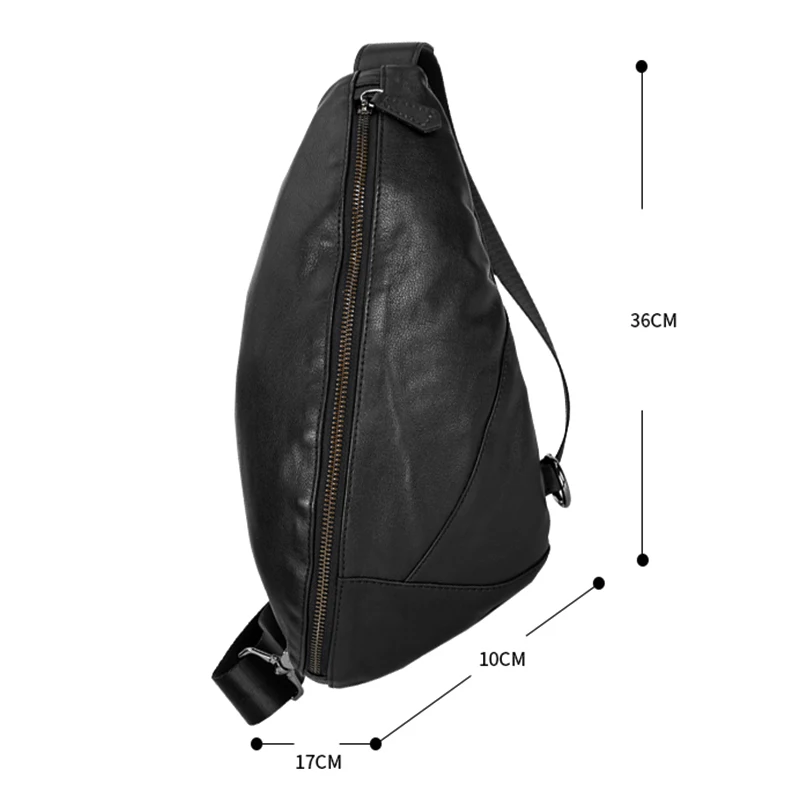
Questions to Ask Retailers
Quality retailers should be able to answer these questions:
– What specific type of leather is used? (Not just “genuine leather”)
– How is the leather tanned and finished?
– What is the expected lifespan with proper care?
– What’s the warranty coverage and process?
– What maintenance does the leather require?
Vague or dismissive answers often indicate the seller may not be knowledgeable about their products.
Online Shopping Considerations
When purchasing online without physical inspection:
- Look for detailed, high-resolution photos showing close-ups of leather texture and stitching
- Check return policies and whether they cover “not as described” situations
- Read reviews that specifically mention leather quality and durability
- Research the brand’s reputation for quality and customer service
- Look for detailed material and construction specifications
Red Flags That Indicate Poor Quality
Be wary of these warning signs:
– Extremely light weight for the size (indicates thin leather or partial synthetic construction)
– Strong chemical smell rather than natural leather scent
– Perfectly uniform leather with no natural variations
– Painted or pigmented surface that obscures natural grain
– Vague material descriptions (“genuine leather” without specifics)
– Unrealistically low prices for claimed leather quality
– Excessive focus on appearance with minimal discussion of construction
Documentation to Request
Ask for these materials to support your purchase:
– Detailed leather care instructions
– Written warranty information
– Material certification (particularly for premium leather types)
– Proper leather cleaning product recommendations
Finding the Perfect Balance: Making Your Final Decision
After considering all factors, the final decision comes down to finding the right balance between your specific needs, preferences, and budget constraints. This framework helps prioritize what matters most for your situation.
Prioritizing Based on Personal Needs
Create a personalized hierarchy of importance by ranking these factors:
1. Intended use (daily commute, travel, professional settings)
2. Carrying capacity requirements
3. Organization needs (laptop, documents, small items)
4. Aesthetic preferences
5. Budget constraints
Your specific ranking determines which compromises make sense for your situation. A student might prioritize capacity and organization over premium materials, while a professional might value aesthetics and material quality over maximum storage space.
Balancing Competing Considerations
Most purchase decisions involve trade-offs between:
– Higher quality materials vs. budget constraints
– Maximum functionality vs. clean aesthetics
– Traditional design vs. modern features
– Ideal size vs. weight considerations
The key is identifying which compromises align with your priorities and which would significantly impact your satisfaction. For example, compromising on leather quality often leads to disappointment, while adapting to a different organizational layout might be a reasonable adjustment.
Trusting Craftsmanship Over Marketing
Focus on tangible quality indicators rather than brand prestige or marketing claims:
– Examine the actual construction details
– Evaluate the leather quality firsthand when possible
– Consider the warranty as an indication of the manufacturer’s confidence
– Research the brand’s reputation among leather enthusiasts
For travelers with specific needs, understanding how to select travel rucksacks provides additional considerations for durability and functionality during journeys.
Finding Your Perfect Match
The right leather rucksack should:
– Meet your functional requirements without unnecessary complexity
– Fit your body comfortably when loaded with typical contents
– Complement your personal style and typical attire
– Provide quality appropriate to your expected usage frequency
– Represent a reasonable value based on quality-to-price ratio
Remember that the perfect rucksack isn’t necessarily the most expensive or feature-rich option, but rather the one that best aligns with your specific combination of needs and preferences.
Your Leather Rucksack Journey: Beyond the Purchase
Acquiring your leather rucksack marks the beginning of a relationship that will evolve over years of use. Understanding what to expect during this journey helps you appreciate how your bag will transform from a purchase into a personal artifact.
Breaking In Your New Leather Rucksack
Like fine shoes or a quality leather jacket, premium leather rucksacks require a breaking-in period:
– Initial stiffness is normal and will gradually soften with use
– Straps may feel firm at first but will conform to your shoulder shape
– Some hardware movement might be tight initially and become smoother over time
– The leather will gradually develop a subtle sheen as it absorbs natural oils from handling
This evolution process typically takes several weeks of regular use, with the most dramatic softening occurring in the first month.
The First Few Months of Ownership
During the initial period, you’ll notice:
– The leather beginning to develop subtle color variations that add character
– Edges and corners slightly softening from contact with surfaces
– The bag gradually molding to your body and carrying habits
– Hardware developing a broken-in feel and operation
These changes represent the beginning of patina development—the desirable aging process that makes quality leather goods more beautiful over time.
Evaluating Your Choice
After several months of use, you’ll be able to properly assess your selection:
– Has the bag accommodated your typical loads comfortably?
– Does the organization system work intuitively for your needs?
– Has the leather responded well to your environment and use patterns?
– Do you find yourself enjoying using the rucksack rather than seeing it as utilitarian?
This period reveals whether your research and selection process aligned with your actual needs or if adjustments might be required for future purchases.
The Long-Term Relationship
Unlike disposable fashion accessories, a quality leather rucksack becomes more personally meaningful with time:
– The patina will continue developing, reflecting your unique usage patterns
– Small scratches and marks become part of its character rather than flaws
– The leather softens further while maintaining structural integrity
– The bag becomes an extension of your personal style and daily routine
This transformation from a manufactured product to a personal artifact represents the special quality that makes premium leather goods uniquely satisfying as long-term companions.
A well-chosen leather rucksack doesn’t just serve a functional purpose—it becomes part of your personal journey, developing character that tells the story of your experiences together.

